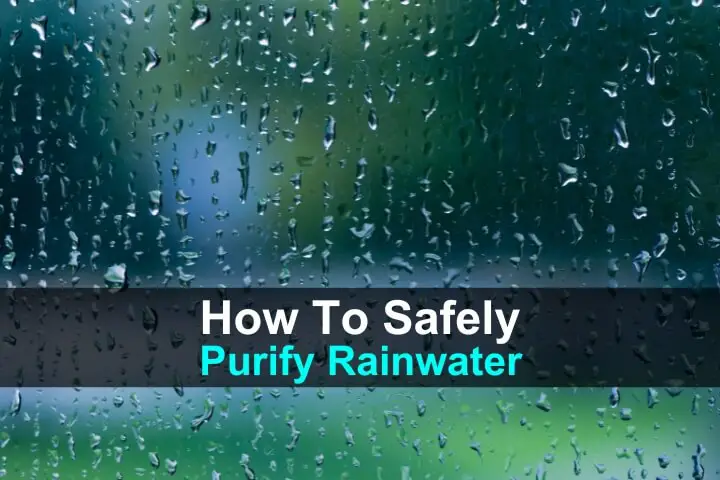Estimated studying time: 6 minutes

If you happen to’re interested by harvesting rainwater in case of catastrophe, or when you’re simply making an attempt to cut back your water consumption and lower your expenses, there are some things you need to kn ow.
Rainwater is commonly regarded as a pure and pure supply of water, however this isn’t solely true. Whereas rainwater may appear protected as a result of it falls from the sky, it isn’t. In response to a number of research, rainwater is not protected to drink. Sadly, the environment is stuffed with all types of contaminants, together with harmful chemical substances.
There are additionally catchment contaminants. Sticking a bucket out within the yard and ready for it to fill is fairly inefficient. Then you need to take into consideration what’s within the bucket. What if a chicken flies and poops in it, or what if the wind is blowing and stuff falls into the water?
After which there’s the commonest methodology of harvesting rainwater: roofs.
Wish to save this submit for later? Click on Right here to Pin It On Pinterest!
Contamination of Rainwater from Rooftops
Roofs are sometimes coated with substances like tar, asphalt, and paints that may leach chemical substances into the water. Moreover, roofs accumulate chicken droppings, insect particles, tree leaves, branches, and so forth.
All of this contributes to bacterial and viral contamination. When rain falls on a roof and slides down your gutter and even instantly into your rain barrel, it’s making a cocktail of probably dangerous water. There’s additionally the issue with metallic rooftops. Lead-based paints or galvanized metals can add result in the water, which may trigger all types of well being issues.
Because the rainwater flows via gutters and downspouts, it continues to soak up extra contaminants, specifically the natural matter that we simply talked about within the final paragraph. That natural matter is all that you must promote the expansion of algae and micro organism in storage tanks.
Atmospheric Contamination: PFAS in Rainwater
Even rainwater that doesn’t come into contact with a roof isn’t essentially protected. A examine by the Environmental Working Group (EWG) revealed the presence of PFAS—a bunch of artificial chemical substances that keep within the setting and human physique.
PFAS are the “perpetually chemical substances” talked about earlier. They keep within the human physique perpetually as a result of they don’t break down simply. Sadly, these chemical substances have been linked to antagonistic well being results reminiscent of most cancers, immune system suppression, and developmental points in youngsters.
The analysis revealed alarming ranges of PFAS in rainwater, even in distant areas the place you’ll assume there isn’t any air pollution within the air. These chemical substances enter the environment via industrial emissions, use of firefighting foams, and shopper merchandise.
As soon as airborne, PFAS can journey lengthy distances earlier than being deposited again to Earth by way of rain and snow. Even when you dwell on prime of a pristine mountain or means out within the boonies, rainwater can nonetheless comprise dangerous ranges of those chemical substances.
Strategies to Purify Rainwater
Given the contaminants that may taint rainwater, purification is crucial earlier than it may be used for consuming. A number of strategies can take away impurities, together with perpetually chemical substances, from rainwater. If rainwater is your solely choice for consumption, there are methods to make it protected to drink.
1. Activated Carbon Filtration
Carbon filters are very efficient at eradicating natural contaminants, chlorine, and a few PFAS compounds from water. These filters work by adsorbing chemical substances onto the floor of the carbon materials as water passes via. The carbon acts like sicky fingers and grabs the nasty stuff from the water.
Execs:
- Efficient at eradicating a variety of natural chemical substances and enhancing water style.
- Available and inexpensive.
- Simple to put in and preserve.
Cons:
- Restricted lifespan; filters have to be changed frequently. The extra water you run via them, the faster you’ll want to switch the filter.
- Not efficient towards all sorts of PFAS or heavy metals.
- Requires pre-filtration if the water accommodates a variety of sediment.
2. Reverse Osmosis (RO)
Reverse osmosis filters work by forcing water via a semi-permeable membrane, leaving contaminants like heavy metals, PFAS, and microorganisms behind.
Execs:
- Removes a variety of contaminants, together with most PFAS.
- Produces very high-quality, purified water.
Cons:
- Costly to put in and function.
- Generates wastewater, which could be an environmental concern.
- Requires common upkeep and alternative of membranes. Once more, the extra water you filter, the extra steadily you’ll have to switch membranes.
3. Ion Alternate Resins
Ion change resins can be utilized to focus on particular contaminants like PFAS and heavy metals. These programs work by exchanging dangerous ions within the water with protected ones. The resins appear like tiny beads or sand. This methodology is commonly utilized in water softeners.
Execs:
- Efficient at eradicating particular contaminants.
- Might be mixed with different purification programs for enhanced effectiveness.
Cons:
- Not a standalone answer for complete purification. You’ll must boil and filter the water.
- Resins must be changed typically if the water is especially ‘soiled’ and also you’re filtering quite a bit.
- Might not take away organic contaminants.
4. Distillation
A water distiller entails boiling water and condensing the steam again into liquid, leaving most contaminants behind.
Execs:
- Efficient at eradicating most contaminants, together with PFAS, heavy metals, and microorganisms aka micro organism and fungi that may make an individual sick.
- Produces extremely purified water.
Cons:
- Vitality-intensive and gradual course of. It’s going to take hours to get a small quantity of water.
- Requires specialised gear.
- Can take away helpful minerals, leading to flat-tasting water.
5. UV Sterilization
Ultraviolet mild programs disinfect water by killing micro organism, viruses, and different pathogens.
Execs:
- Efficient at eliminating organic contaminants.
- Environmentally pleasant; no chemical substances are added.
Cons:
- Ineffective towards chemical contaminants like PFAS or heavy metals.
- Requires pre-filtration for cloudy water.
- Most programs are depending on electrical energy. Nevertheless, there are some battery-powered sticks you need to use for a jug or water bottle.
6. Mixed Programs
Utilizing a mix of purification strategies is mostly your greatest wager. For instance, a system may embrace sediment filtration, activated carbon, reverse osmosis, and UV sterilization. That is usually how should water filtration programs work.
Execs:
- Removes a variety of contaminants.
- Can arrange on your particular water high quality points.
Cons:
- Excessive preliminary price and upkeep necessities. As a substitute of shopping for a single system or filter, you’ll want to purchase a number of and have further readily available. Shopping for in bulk might help make this a bit of less expensive.
- Could be a little harder to put in and would require extra space.
Selecting the Proper Purification Methodology
The most effective methodology for purifying rainwater is determined by what you propose on utilizing the rainwater for and the extent of contamination. For primary family use, activated carbon filtration and UV sterilization is perhaps sufficient. Nevertheless, for consuming water in areas the place PFAS contamination is a priority, reverse osmosis or distillation could also be vital.
At all times check the water to make sure your purification system is functioning successfully. You should buy a check equipment or ship it out to have a lab offer you a full rundown. Normally, this check is beneath 100 bucks. As soon as you realize what tends to be in your rainwater, you possibly can tailor your system to filter out these contaminants.
Nevertheless, if you’re interested by rainwater for survival after an apocalyptic occasion, the air is perhaps extraordinarily tainted with chemical substances. It’s greatest to plan for critical filtration and purification.
Like this submit? Do not Neglect to Pin It On Pinterest!
You Might Additionally Like:


